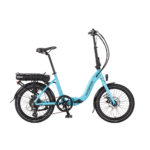At the risk of posting a very dumb question - can I ask about quoted charge cycles for a battery? I presume the number of cycles refer to a fully discharged battery charged back to fully charged. If one was to charge from a 50% charged state to a fully charged state, does that mean the number of charging cycles is likely to be doubled? For example, the Panasonic 18Ah battery is quoted as having around 1000 charging cycles in it. If you charged it from complete discharge to charge every week, then it would last roughly 20 weeks. If you didn't use it so much, but you still recharged every week, say from 50% charge to fully charged every week, would you get 40 weeks of life from it?
What do quoted number of battery charge cycles really mean?
- Thread starter WillT
- Start date
Not really sure about this but from what i have read every charge full or part is classed as a cycle
From my understanding, 2 half cycles would 'roughly' equate to one, bearing in mind that every charge still puts some stress on the cells which reduces the battery life.
Dont even begin to follow your reasoning on a battery lasting ....twenty weeks ????? ...............is this a typo ???

Lynda
Dont even begin to follow your reasoning on a battery lasting ....twenty weeks ????? ...............is this a typo ???
Lynda
I cant see as it means much at all, just numbers.
If you charged your battery twice a week then in theory it should last 9 1/2 years, this is obviously unlikely to happen. Though if you charged it every day, again in theory, it should last 2 3/4 years which is much more likely, but even the commuters among us are unlikely to charge their batteries each and every day.
Just hope at £500+ that it lasts many years
If you charged your battery twice a week then in theory it should last 9 1/2 years, this is obviously unlikely to happen. Though if you charged it every day, again in theory, it should last 2 3/4 years which is much more likely, but even the commuters among us are unlikely to charge their batteries each and every day.
Just hope at £500+ that it lasts many years
Sorry - duh  My maths is obviously not a strong point today - blame it on post-rugby world cup euphoria. So my example was numerically wrong, but the point is still open I think. Try this instead: 2 full charge cycles per week gives about 100 cycles/year so 1000 cycles over 10 years. If the charging were just top-ups from 50% to 100% occurring 4 times per week, would the battery go for 10 years (2000 'half-cycles') or 5 years (1000 cycles of any quantity). I have a 50km (round trip) commute and don't want to run out of charge towards the end (where there is a 70m climb), so I do tend to charge most days. But I worry how long I have before I spend another load of money on a new battery.
My maths is obviously not a strong point today - blame it on post-rugby world cup euphoria. So my example was numerically wrong, but the point is still open I think. Try this instead: 2 full charge cycles per week gives about 100 cycles/year so 1000 cycles over 10 years. If the charging were just top-ups from 50% to 100% occurring 4 times per week, would the battery go for 10 years (2000 'half-cycles') or 5 years (1000 cycles of any quantity). I have a 50km (round trip) commute and don't want to run out of charge towards the end (where there is a 70m climb), so I do tend to charge most days. But I worry how long I have before I spend another load of money on a new battery.
D
Deleted member 4366
Guest
It's not an exact science. There's a lot of variables involved: How much current you draw; how high you charge it; how deep you discharge; temperature; design of the cells; manufacturing methods, etc. The main points are that in theory Lifepo4 lasts about twice as long as a Lipo or LiCoMn. The construction of the battery is important, A battery with 100 or more 18650 cells will more likely fail from metal fatigue of the spot-welds long before the cells give up and, generally, solder joints don't like vibration, so they may fail in any battery if wires are unsupported. Even copper wire will fail from vibration after a while. So, I would say that your 10 years is a theoretical lifetime, but the battery is more likely to fail for another reason than the cells expiring. Also, some say that the cells age regardless of charge cycles and the aging is linked to the cell design and its exact chemistry of which details are rarely available other than marketing claims. Lithium batteries seem to have lifetimes of 2 to 3 years from reports on various forums, but, of course, those batteries were made 2 or 3 years ago. Technology is moving forward all the time, so today's ones are probably better. Lastly, you'll probably be moving on to new things as new products become available. I suspect that new ebike technical developments and new products will be the reason your battery ends up in the recycle bin. Look out for lithium sulphide which has twice the capacity for the same weight as Lifepo4 if only they could make them.
If you ask your question because you're trying to decide what battery to buy, my only advice would be to avoid batteries with 18650 cells, which tend to be rather heavy anyway, and in the beginning, get a cheaper Chinese battery because, if you become serious about ebiking, you'll want another different one soon anyway.
If you ask your question because you're trying to decide what battery to buy, my only advice would be to avoid batteries with 18650 cells, which tend to be rather heavy anyway, and in the beginning, get a cheaper Chinese battery because, if you become serious about ebiking, you'll want another different one soon anyway.
My reason for asking the question is more about how best to treat the battery that I have so that I get the most out of it (stretch my NZD1000 further). By the sounds of things, it doesn't really matter what the quoted number of charge cycles is; there are too many other factors that come into play.If you ask your question because you're trying to decide what battery to buy, my only advice would be to avoid batteries with 18650 cells, which tend to be rather heavy anyway, and in the beginning, get a cheaper Chinese battery because, if you become serious about ebiking, you'll want another different one soon anyway.
I understand it as one full discharge/recharge cycle, but as stated that obviously depends given the battery is not often fully discharged.
This is the very reason that I went down the small DIY A123 12s1p (36v, 2.3Ah) pack route.

In my application of a fairly flat 10.5 mile round trip commute they work perfectly although may not be best in all applications. I can get to work and back on one charge, but tend to recharge them at work with general consensus that they will last longer than if they are always fully discharged.
This current pack is nearly 2 years old, has over 500 charge cycles, done 2500 miles and worked flawlesly holding charge and balance during that time. I have just had to change one cell though which failed but am hoping to get maybe another year out of it as a have a few more spare single cells. These DIY packs cost me about £70 each to build. I have thought about getting a larger battery, but decided to spread the cost and risk of being off the road with a failed battery by having two or three of these packs instead. That also has the added advantage in that I can carry only the number needed for my journey to save on weight, important in my Brompton application.
Regards
Jerry
This is the very reason that I went down the small DIY A123 12s1p (36v, 2.3Ah) pack route.

In my application of a fairly flat 10.5 mile round trip commute they work perfectly although may not be best in all applications. I can get to work and back on one charge, but tend to recharge them at work with general consensus that they will last longer than if they are always fully discharged.
This current pack is nearly 2 years old, has over 500 charge cycles, done 2500 miles and worked flawlesly holding charge and balance during that time. I have just had to change one cell though which failed but am hoping to get maybe another year out of it as a have a few more spare single cells. These DIY packs cost me about £70 each to build. I have thought about getting a larger battery, but decided to spread the cost and risk of being off the road with a failed battery by having two or three of these packs instead. That also has the added advantage in that I can carry only the number needed for my journey to save on weight, important in my Brompton application.
Regards
Jerry
Last edited:
There is a general intention that it's understood as a complete charge discharge cycle, but the chemical stress of carrying out any charging or discharging means the proportion of any charge/dischange is not pro-rata. The cyclic preference of some types like lithium for charging little and often renders the charge cycle indication less than useful.
For 2012, one manufacturer, Kalkhoff, is starting to give not only charge cycles indications but also total battery life indications in road kilometres, together with some sensible variability indications. How useful this will be only time can tell, but at least the issue is being thought about.
For 2012, one manufacturer, Kalkhoff, is starting to give not only charge cycles indications but also total battery life indications in road kilometres, together with some sensible variability indications. How useful this will be only time can tell, but at least the issue is being thought about.
As I've said here before, I sometimes run my battery down to the flashing light, sometimes I recharge it after a couple of miles if I want max range in hand for a trip, basically just treat it any way I want.
After two years of that, the battery still shows 5 conditioning lights and the range has dropped from around 30 to 27 to 28 miles on a full charge.
It seems to me that there is enough headroom with these modern batteries and their BMS that you can just use them without worry and that the life will be little affected whatever you do.
After two years of that, the battery still shows 5 conditioning lights and the range has dropped from around 30 to 27 to 28 miles on a full charge.
It seems to me that there is enough headroom with these modern batteries and their BMS that you can just use them without worry and that the life will be little affected whatever you do.
So I guess you do a lot of the work yourself? Otherwise I'd have thought if the motor draws about 7 amps then you'd only get about 20 minutes or 5 miles from a charge?This is the very reason that I went down the small DIY A123 12s1p (36v, 2.3Ah) pack route.
In my application of a fairly flat 10.5 mile round trip commute they work perfectly although may not be best in all applications. I can get to work and back on one charge
There are never any dumb questions, just dumb answers.
I hope this is not one of them.
Personally I cannot be bothered to try to work out or understand how many times I can charge my battery. If it failed after 6 months or lost power significantly then I would want it replacing under warranty. I use my bike most days and therefore it is charged most days. If it lasts 2 years I think I will think I have had good use out of it.
The important thing for me is that I remember to keep it topped up every time I come home. I have had it 6 months and I have not noticed any power loss at all.
Steve
I hope this is not one of them.
Personally I cannot be bothered to try to work out or understand how many times I can charge my battery. If it failed after 6 months or lost power significantly then I would want it replacing under warranty. I use my bike most days and therefore it is charged most days. If it lasts 2 years I think I will think I have had good use out of it.
The important thing for me is that I remember to keep it topped up every time I come home. I have had it 6 months and I have not noticed any power loss at all.
Steve
They give most Lithium batteries a shelf life of 2ish years before the natual chemical breakdown in parts.
However this will only decrease capacity and increase resistance.
This in real world terms would mean you'd only get 80% of the mileage you used to get when the battery was new.
The real crux of it is that because of the higher resistance the cells will have a much greater voltage sag when drawing power. This usually means that most BMS or controller cut outs will happen far quicker than when the cells are used.
You could buy a very large battery much greater capacity than needed and although it would still have the same chemical breakdown as your not using it to its full potential you'd not really notice it.
Therefore the 18ah battery will feel like it will last longer.
However this will only decrease capacity and increase resistance.
This in real world terms would mean you'd only get 80% of the mileage you used to get when the battery was new.
The real crux of it is that because of the higher resistance the cells will have a much greater voltage sag when drawing power. This usually means that most BMS or controller cut outs will happen far quicker than when the cells are used.
You could buy a very large battery much greater capacity than needed and although it would still have the same chemical breakdown as your not using it to its full potential you'd not really notice it.
Therefore the 18ah battery will feel like it will last longer.
Related Articles
-
 MTF Enterprises announces acquisition of EMU Electric Bikes
MTF Enterprises announces acquisition of EMU Electric Bikes- Started by: Pedelecs
-
 Wisper 806T folding bike wins Which? ‘Best Buy’
Wisper 806T folding bike wins Which? ‘Best Buy’- Started by: Pedelecs
-
 Sustrans calls for protected cycle lanes
Sustrans calls for protected cycle lanes- Started by: Pedelecs
-
 Amazon launch their first UK e-cargo micromobility hub
Amazon launch their first UK e-cargo micromobility hub- Started by: Pedelecs


